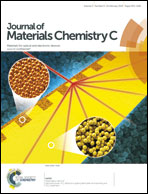Syntheses, photoluminescence and electroluminescence of four heteroleptic iridium complexes with 2-(5-phenyl-1,3,4-oxadiazol-2-yl)-phenol derivatives as ancillary ligands†‡
Abstract
Four new iridium(III) cyclometalated complexes (Ir1–Ir4) with 4-trifluoromethylphenylpyridine as the main ligand and 2-(5-phenyl-1,3,4-oxadiazol-2-yl)-phenol and its fluoro/trifluoromethyl substituted derivatives as ancillary ligands have been developed. All complexes are green phosphors (λmax = 519–537 nm) with photoluminescence quantum efficiency yields of 10–53% in CH2Cl2 solutions at room temperature, respectively. The organic light emitting diodes (OLEDs) with the structure of ITO/TAPC (1,1-bis[4-(di-p-tolylamino)phenyl]cyclohexane, 60 nm)/Ir complexes (8 wt%):SimCP2 (bis[3,5-di(9H-carbazol-9-yl)phenyl] diphenylsilane, 30 nm)/TPBi (1,3,5-tri(1-phenyl-1H-benzo[d]imidazol-2-yl)phenyl, 90 nm)/LiF (1 nm)/Al (100 nm) show good performances. In particular, device G4 based on complex Ir4 (2-(5-pentafluorophenyl-1,3,4-oxadiazol-2-yl)-phenol as ancillary ligand) showed superior performances with a peak current efficiency (ηc) of 70.48 cd A−1 and a peak external quantum efficiency (ηext, EQE) of 19.7%. This study demonstrates that the ancillary ligand attached with the 1,3,4-oxadiazole group could facilitate charge trapping across the bulk of the device for efficient OLEDs.


 Please wait while we load your content...
Please wait while we load your content...